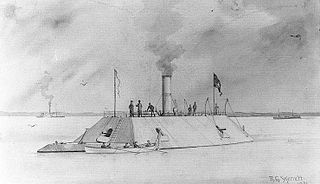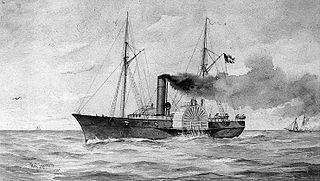
H. L. Hunley, also known as the Hunley, CSS H. L. Hunley, or CSS Hunley, was a submarine of the Confederate States of America that played a small part in the American Civil War. Hunley demonstrated the advantages and dangers of undersea warfare. She was the first combat submarine to sink a warship (USS Housatonic), although Hunley was not completely submerged and, following her attack, was lost along with her crew before she could return to base. Twenty-one crewmen died in the three sinkings of Hunley during her short career. She was named for her inventor, Horace Lawson Hunley, shortly after she was taken into government service under the control of the Confederate States Army at Charleston, South Carolina.

USS Keokuk was an experimental ironclad screw steamer of the United States Navy named for the city of Keokuk, Iowa. She was laid down in New York City by designer Charles W. Whitney at J.S. Underhill Shipbuilders, at the head of 11th Street. She was originally named Moodna, but was renamed while under construction, launched in December 1862 sponsored by Mrs. C. W. Whitney, wife of the builder, and commissioned in early March 1863 with Commander Alexander C. Rhind in command.

The Confederate States Navy (CSN) was the naval branch of the Confederate States Armed Forces, established by an act of the Confederate States Congress on February 21, 1861. It was responsible for Confederate naval operations during the American Civil War against the United States's Union Navy.

Charles William Read, known commonly as "Savez", was an officer in the antebellum United States Navy and then in the Confederate Navy during the American Civil War. He was nicknamed the "Seawolf of the Confederacy" for his exploits and daring.

CSS Palmetto State was one of six Richmond class casemate ironclad rams built for the Confederate States Navy during the American Civil War. Completed in 1862, she defended Charleston, South Carolina and was burnt in 1865 to prevent her capture by advancing Union troops.

CSS Chicora was a Confederate ironclad ram that fought in the American Civil War. It was built under contract at Charleston, South Carolina in 1862. James M. Eason built it to John L. Porter's plans, using up most of a $300,000 State appropriation for construction of marine batteries; Eason received a bonus for "skill and promptitude." Its iron shield was 4 inches (102 mm) thick, backed by 22 inches (559 mm) of oak and pine, with 2-inch (51 mm) armor at its ends. Keeled in March, it was commissioned in November, Commander John Randolph Tucker, CSN assuming command.

CSS Nashville was a brig-rigged, side-paddle-wheel passenger steamer that served with the Confederate Navy during the Civil War.
CSS Raleigh was a steam-powered Civil War casemate ironclad. She was fitted with a spar torpedo instead of an iron ram and was built in 1863–1864 by the Confederate States Navy at Wilmington, North Carolina. While she was being built her commander was Lieutenant John Wilkinson (CSN). She was put into commission on April 30, 1864 under the command of Lieutenant J. Pembroke Jones, CSN.
The CSS Beaufort was an iron-hull gunboat that served in North Carolina and Virginia during the American Civil War. Originally launched as Caledonia at Wilmington, Delaware, in 1854, the ship was owned by James Cathcart Johnston. It saw use as a tugboat on the Dismal Swamp Canal. On July 9, 1861, Beaufort was commissioned into the navy of the state of North Carolina for use in the American Civil War. First serving on the North Carolina coast, Beaufort was present at the battles of Roanoke Island and Elizabeth City in February 1862. Escaping the Confederate defeat at Elizabeth City via the Dismal Swamp Canal, Beaufort reached Norfolk, Virginia, where she joined the James River Squadron.

CSS David was an American Civil War-era torpedo boat. On October 5, 1863, she undertook a partially successful attack on USS New Ironsides which was participating in the blockade of Charleston, South Carolina.

William Augustin Webb (1824-1881) was an American sailor and Mexican–American War veteran who resigned his United States Navy commission after more than 20 years of service to join the Confederate States Navy in the American Civil War. Webb was decorated for his service as Captain of the CSS Teaser, part of the James River Squadron, during the Battle of Hampton Roads (1862).

USS Sciota was a Unadilla-class gunboat built on behalf of the United States Navy for service during the Civil War. She was outfitted as a gunboat, with both a 20-pounder rifle for horizontal firing, and two howitzers for shore bombardment, and assigned to the Union blockade of the waterways of the Confederate States of America.
CSSIsondiga was a wooden gunboat that served in the Confederate States Navy during the American Civil War. Designed according to Matthew Fontaine Maury's plan to produce a large number of small vessels to swamp the Union blockade, Isondiga was one of only two or three of these Maury gunboats actually completed, and the only one completed as designed. The Maury gunboats project had been almost entirely cancelled in favor of ironclad production after the Battle of Hampton Roads. Isondiga was built in Savannah, Georgia, and was transferred to the Confederate Navy in January 1863 to begin the fitting out process. At this time, she was commanded by Lieutenant Joel S. Kennard.
USS Yankee was a steam-powered side-wheel tugboat acquired by the Union Navy just prior to the outbreak of the American Civil War.

USS Octorara was a steamer acquired by the Union Navy during the American Civil War. She was used by the Navy to patrol navigable waterways of the Confederacy to prevent the Confederates from trading with other countries.

USS Kinsman, sometimes called USS Colonel Kinsman, was a sidewheel steamer captured by the Union Army during the American Civil War. She was used by the Army and then by the Union Navy as a gunboat in support of the Union Navy blockade of Confederate waterways. On 23 February 1863, she hit a snag and sank.
George Washington Gift (1833–1879), U.S. Navy officer, writer, banker, civil engineer, politician, Confederate Navy officer, businessman, and newspaper editor.

The attack on USS New Ironsides in October 1863 was one of the first successful torpedo boat engagements in history. Confederate forces in Charleston, South Carolina deployed the newly built semi-submersible CSS David to attach a spar torpedo to the hull of USS New Ironsides. Though the attack is regarded as a rebel victory, the Union ship was saved from serious damage.

During the American Civil War, blockade runners were used to get supplies through the Union blockade of the Confederate States of America that extended some 3,500 miles (5,600 km) along the Atlantic and Gulf of Mexico coastlines and the lower Mississippi River. The Confederacy had little industrial capability and could not produce the quantity of arms and other supplies needed to fight against the Union. To meet this need, British investors financed numerous blockade runners that were constructed in the British Isles and were used to import the guns, ordnance and other supplies, in exchange for cotton that the British textile industry needed greatly. To penetrate the blockade, these relatively lightweight shallow draft ships, mostly built in British shipyards and specially designed for speed, but not suited for transporting large quantities of cotton, had to cruise undetected, usually at night, through the Union blockade. The typical blockade runners were privately owned vessels often operating with a letter of marque issued by the Confederate government. If spotted, the blockade runners would attempt to outmaneuver or simply outrun any Union Navy warships on blockade patrol, often successfully.













